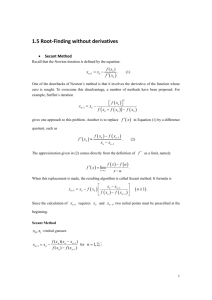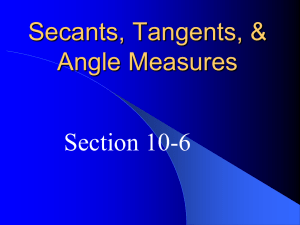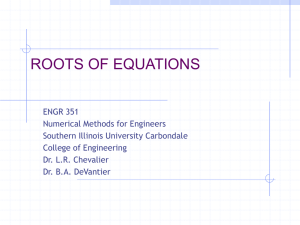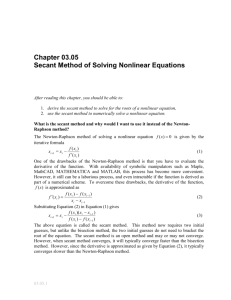Full text
advertisement
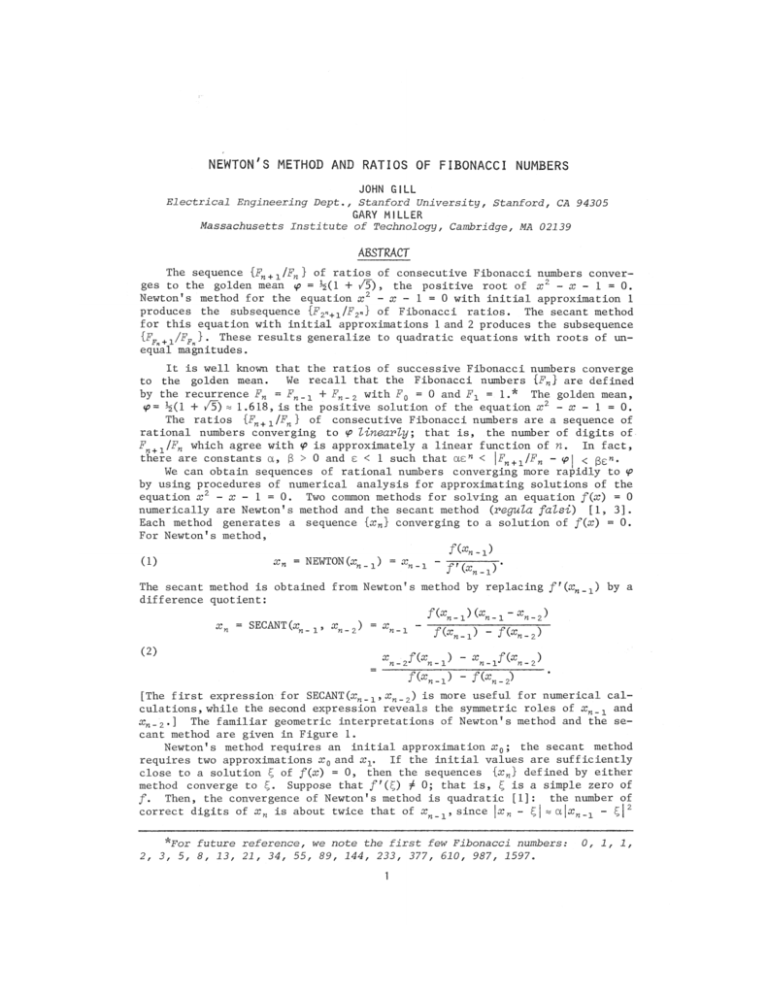
NEWTON'S METHOD AND RATIOS OF FIBONACCI NUMBERS
JOHN
Electrical
Engineering
Dept.,
GILL
Stanford
University,
Stanford,
CA 94305
GARY M I L L E R
Massachusetts
Institute
of Technology,
Cambridge,
MA 02139
ABSTRACT
The sequence {Fn + 1/Fn} of ratios of consecutive Fibonacci numbers converges to the golden mean <p = %(1 + /5) , the positive root of x2 - x - 1 = 0.
Newton1 s method for the equation x2 - x - 1 = 0 with initial approximation 1
produces the subsequence {F2n+1/F2n} of Fibonacci ratios. The secant method
for this equation with initial approximations 1 and 2 produces the subsequence
{Fp +1/FF }. These results generalize to quadratic equations with roots of unequal magnitudes,
It is well known that the ratios of successive Fibonacci numbers converge
to the golden mean. We recall that the Fibonacci numbers {Fn} are defined
by the recurrence Fn = Fn_1 + Fn_2 with F 0 = 0 and F1 =. 1.* The golden mean9
<p= %(1 + /5) « 1.618, is. the positive solution of the equation x2 - x - 1 = 0.
The ratios {Fn+i/Fn}
° f consecutive Fibonacci numbers are a sequence of
rational numbers converging to <p- li-nearly;
that is, the number of digits of
Fn+1/Fn
which agree with <p is approximately a linear function of n, In fact,
there are constants a, 3 > 0 and e < 1 such that ae n < |.FM+ 1 /F n - <p\ < ge»,
We can obtain sequences of rational numbers converging more rapidly to <p
by using procedures of numerical analysis for approximating solutions of the
equation x2 - x - 1 = 0 . Two common methods for solving an equation f{x) = 0
numerically are Newton*s method and the secant method (regula fals-i)
[1, 3].
Each method generates a sequence {xn} converging to a solution of f(x)
= 0.
For Newton1s method,
(1)
xn
= NEWTON(a^.j) = xH_±
- jr^
y
The secant method is obtained from Newton's method by replacing f'(xn_1)
difference quotient:
Xn
= SECANTfe^. xn_2)
= *„., -
by a
/<*n-l>(*»-l-*„-2>
/(x?j_i) _ /(aii_2)
rc-2^ v n - l '
n-1*' v
n-2'
X
/(^n-l) ~ A n-2^
[The first expression for SECANT (#n _ x , a:n _ 2 ) is more useful for numerical calculations, while the second expression reveals the symmetric roles of xn_1 and
xn„2,]
The familiar geometric interpretations of Newtonfs method and the secant method are given in Figure 1.
Newtonfs method requires an initial approximation x0; the secant method
requires two approximations xQ and x±« If the initial values are sufficiently
close to a solution 5 of f(%) = 0* then the sequences {xn} defined by either
method converge to £. Suppose that f'(Q
f 0; that is, £ is a simple zero of
/. Then, the convergence of Newton1s method is quadratic [1]: the number of
correct digits of xn is about twice that of x
, since \xn - £ | ^ a\xn_1
- E,\
2,
*For future
3f 5f 8, 13,
reference,
we note the first
few Fibonacci
21, 34, 55, 89, 144, 233, 377, 610, 987,
1
numbers:
1597.
0f
1,
1,
NEWTON'S METHOD AND RATIOS OF FIBONACCI NUMBERS
2
[Feb.
for some a > 0. Similarly, the order of convergence of the secant method
is v? % 1.618. since
for some a > 0 [3].
ou#«
/<*»-2Hslope
/<*»-!>-
^*»-i>+
r
)
f (x
J
K
n-lJ
•^n -2
n-l
(a J
Fig.
1.
Newton's
Geometric
method
interpretations
(b)
of
Newton's
*~n-2
^n-l
^n
Secant
method
method
and
secant
method
0 yield sequences
Both these methods applied to the equation x2
x - 1
converging to <P more rapidly than {Fn+ /Fn}.
For this equation, we calculate
easily that
+ 1
+ 1
(3)
NEWTON(x n _ 1 )
and
SECANT(xn_ls
xn_2)
x
2x„
1
.1 + n-2
1
For initial approximations to <P, it is natural to choose Fibonacci ratios.
For example, with xQ = 1, Newton's method produces the sequence,
1, 2/1, 5/3, 34/21, 1597/987, ...,
which we recognize (see note on page 1) as a subsequence of Fibonacci ratios.
From a few more sample calculations [e.g.,
NEWTON(3/2) = 13/8
or
NEWTON(8/5) = 89/55]
we infer the identityi
(4)
NEWTON
(F^/F)
F
IF
,
2n+l' 2n
The sequence {xn} generated by Newton*s method with xQ = 1 is defined by xn =
F2„ -IF
. Now it is obvious that the convergence of \xn} is quadratic, since
there are constants a, £ > 0 and e < 1 such that ae2n < \xn - *P\ < $szn.
We can similarly apply the secant method with Fibonacci ratios as initial
approximations. From examples such as
SECANT(1, 2) = 3/2, SECANT(2, 3/2) = 8/5, and SECANT(3/2, 8/5) = 34/21,
we infer the general rule:
(5)
SECANT(Fm+1/Fm,
Fn+1/Fn)
= Fm + n + 1/Fm+n
.
In particular, if x1 = 1 and x2 ~ 2, then the sequence {x n] generated by the
secant method is given by xn = FF +1/FF
. Since Fn is asymptotic to <pn//59
there are constants a, @ > 0 and e < 1 such that ae*n< \xn - <?\ < £>£*", which
dramatically illustrates that the order of convergence of the secant method
is *f.
Equations (4) and (5) are interesting because they imply that the sequences
of rational approximations to (p produced by Newton's method and by the secant
method are simple subsequences of Fibonacci ratios.
1981]
NEWTON'S METHOD AND RATIOS OF FIBONACCI NUMBERS
3
We now verify (4) and (5), In fact, these identities are valid in general
for any sequence {un} defined by a second-order linear difference equation
with uQ = 0 and u± = 1, provided the sequence iun+1/un}
is convergent.
Lemma i Let {un} be defined by aun + bun_± + oun^2 = 0 with u0 = 0 and uL = 1.
Then aum+1un+1
- cw m w M - a w w + n + 1 for all m, n ^ 0*
Vhjoo^i By induction on n.
au
For n - Q, the lemma holds for all m since
m+lul
cu
"
muo
=
au
m+le
Now assume that for n - 1 the lemma is true for all m»
aU
m+lUn+l
" °UmU
=
~
( ^ n
au
U
m+2
aU
=
a
CU
n-l^Um+I
"
n
+
cu
™
^
+2
Then
+
hu
m
+
JUn
u
m+l n-l
(m +i) + (w - 1) +1
\ +n+l'
D
The lemma g e n e r a l i z e s t h e F i b o n a c c i i d e n t i t y
p
p
+ p p - p
J-m + l^n
+l
^
L
mJ-n
J-m +
[2]:
n+i*
Suppose that ax2 + bx + a has distinct zeros X± and A2, Any sequence
satisfying the recurrence aun + bun_x + oun_2 = 0 is of the form
{un}
u n = k ^ l + /c2A*s
are
where k1 and ?C2
constants determined by the initial values u0 and uim
If
| A i| > l^2| an<^ '^1 ^ ®» then w n is asymptotic to /C-LA-L, and so {u n+1 /u n } converges linearly to XL. We now show that if u0 = 0 and w3 = 1, then Newtonfs
method and the secant method, starting with ratios from {un+1/un}9
generate
subsequences of
{un+1/un}.
Th2.0H.em: Let {un} be defined by aun + bun „x + cun _2 = 0 with u 0 = 0 and u L = 1.
If the characteristic polynomial f(x)
= ax2 + bx + c has zeros XL and A2 with
I X-j_ J > I X2 I s then:
(i) un + 0 for all n > 0;
(ii)
lim un+1/un
= Ax;
(iii) NEWTON(u n+1 /u n ) =
(iv)
uZn+1/uZn;
SECANT(u m+1 /u m , un+1/un)
= u
(i) It is easily verified that u n = /c(A" - A n 2 ), where fc = ±a/Sb2 - 4ac.
(The sign of /c depends on the signs of a and 2?.) Since |AX| > |A2|, if n > 0,
then I Ai| > |X"| and, therefore, un £ 0,
(Ii) We note, as an aside, that the sequence {un+1/un}
satisfies the
first-order recurrence xn = ~(bxn_1
+ o)/axn_1.
To verify (ii):
HX"+I
u
——-
Un
=
- xr 1 )
—
—
ka\ -
xn2)
1 - (\A
)M+I
Y
= A,—
A
as n > » ,
since
A , / A 2 | < 1.
i - (x^x.r
(Iii) For the equation ax2 + bx + c = 0, Newtonfs method and the secant
method are given by
(6) NEWTON(x
"-1
) =-— U lax
n-1
-T- and
+ b
SECANT(x
,x
) =
J
n-is n-27 a (#
+ a?
n-1
) + b°
n-2
A CHARACTERIZATION-OF THE FUNDAMENTAL SOLUTIONS.TO
PELL'S EQUATION u2
- Dv2
= C
[Feb.
Therefore, NEWTON(#n_x) = SECANT(a?„_x , xn_1)9
and so (iii) follows from-(iv).
Note that this identity holds for any polynomial equation f(x)
=0.
(iv) By (6),.
SECANT(u m+1 /u m9
un+1/un)
a(um+1/um)(un+1/un)
-a
a(um+1/um + M n + l / " « ) + b
aU
aU
m+lUn+l
u
m+l n
aU
+
U
*+l n+l
U
mu n
+ bumun
~
CM M
m *
(by the lemma)
aum+n+1/aum+n
Remcmki* t
SU
~
au u
m „+l
m+n+l'Um+n9
D
1. The theorem does not generalize to polynomials of degree higher than 2.
2. Not only do the ratios of the consecutive Fibonacci numbers converge to
ip9 they are the "best" rational approximation to #>; i.e M if n > 1, 0 < F <_ Fn
and P/F + Fn + 1/Fn9
then \Fn + 1/Fn-<p\
< \P/F-<P\ by [4]. Since Newton's method
and the secant method produce subsequences of Fibonacci ratios, they also produce the best rational approximation to <p,
ACKNOWLEVGMEhiTS
The above r e s u l t s were d i s c o v e r e d i n r e s p o n s e t o a q u e s t i o n posed by E r n s t
S p e c k e r . T h i s r e s e a r c h was s u p p o r t e d by t h e N a t i o n a l S c i e n c e F o u n d a t i o n under
Grant GK-43121 a t S t a n f o r d U n i v e r s i t y and by t h e F o r s c h u n g s i n s t i t u t fiir Mathematik, Eidgenossische Technische Hochschule, Zurich.
REFERENCES
1.
2.
3.
4.
P . H e n r i c i . Elements
of Numerical Analysis,
New York: W i l e y , 1964.
D. E. Knuth. The Art of Computer Programming.
V o l . I : Fundamental
Algorithms,
R e a d i n g , M a s s . : Addison-Wesley, 1968.
A. R a l s t o n . A First
Course in Numerical Analysis,
New York: McGraw-Hill,
1965.
G. H. Hardy & E. M. W r i g h t . An Introduction
to the Theory of Numbers, p .
151, Theorem 1 8 1 . London: Oxford, 1968.
A CHARACTERIZATION OF THE FUNDAMENTAL SOLUTIONS TO
P E L L ' S EQUATION
Florida
Atlantic
u2 - Dv2
= C
M. J . DeLEON
University,
Boca Raton,
FL 33432
Due to a confusion originating with Euler, the diophantine equation
(1)
u2 - Dv2 = C9
where M s a positive integer that is not a perfect square and C is a nonzero
integer, is usually called Pell1's equation.
In a previous article [1, Theorem
2], the following theorem was proved.
TkdOKOm I: Let x1 + y 1/D be the fundamental solution to x2 - Dy2 = 1.
If k =
